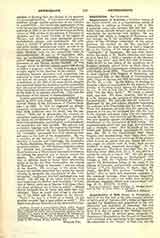

Amphilochius of Iconium, a Christian bishop of the fourth century, son of a Cappadocian family of distinction, b. perhaps at Caesarea, c. 339 or 340; d. probably some time between 394 and 403. His father was an eminent lawyer, and his mother Livia remarkable for gentleness and wisdom. He was probably first cousin to Gregory of Nazianzus, and was brought up in the peculiarly religious atmosphere of the Christian aristocracy of his native province. He studied for the bar, practiced at Constantinople, but soon retired to lead a religious life in the vicinity of his friend and relative, the “theologian” of Nazianzus. He was soon drawn within the circle of St. Basil’s influence, and seems to have been for a while a member of the Christian “City of the Poor” that Basil had built at Caesarea. Early in 374 he was bishop of the important see of Icomum, probably placed there by Basil, whom he continued to aid in Cappadocian ecclesiastical affairs until Basil’s death (379). Thenceforth he remained in close relations with Gregory of Nazianzus, and accompanied him to the Synod of Constantinople (381), where St. Jerome met and conversed with him (De Vir. Ill., c. 133). In the history of theology he occupies a place of prominence for his defense of the divinity of the Holy Spirit against the Macedonians (q.v.). It was to him that St. Basil dedicated his work “On the Holy Spirit“, He wrote a similar work, now lost. We know, however, that he read it to St. Jerome on the occasion of their meeting at Constantinople. His attitude towards Arianism is illustrated by the well-known anecdote concerning his audience with Theodosius and his son Arcadius. When the Emperor rebuked him for ignoring the presence of his son, he reminded him that the Lord of the universe abhorreth those who are ungrateful towards His Son, their Savior and Benefactor. He was very energetic against the Messalians (q.v.), and contributed to the extirpation of that heresy. His contemporaries rated him very high is a theologian and a scholarly writer. Not to speak of his admirers and friends already mentioned, St. Jerome says (Ep. 70) of the Cappadocian triad (Basil, Gregory, and Amphilochius) that “they cram their books with the lessons and sentences of the philosophers to such an extent that you cannot tell which you ought to admire most in them, their secular erudition or their scriptural knowledge”. In the next generation Theodoret described hint in very flattering terms (Hist. Eccl., IV, x; V, xvi), and he is quoted by councils as late as 787. His only genuine extant work is, according to Bardenhewar (Patrologie, p. 249), the “Epistola Synodica”, a letter against the Macedonian heresy in the name of the bishops of Lycaonia, and probably addressed to the bishops of Lycia (Goldhorn, S. Basil., Opp. Sel. Dogm., 630-635). The spurious “Iambics to Seleucus” offer an early and important catalogue of the canonical writings; other spurious fragments, current under his name, are taken from scriptural discourses, dogmatic letters and controversial writings (P.G., XXXIX, 13-130).
THOMAS J. SHAHAN

